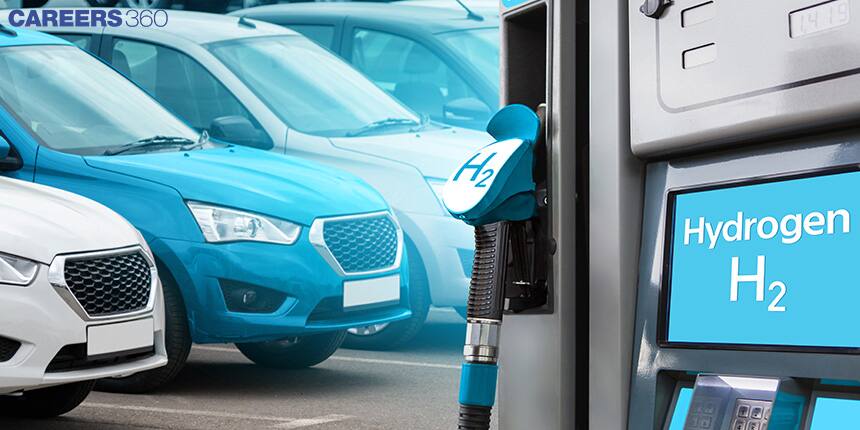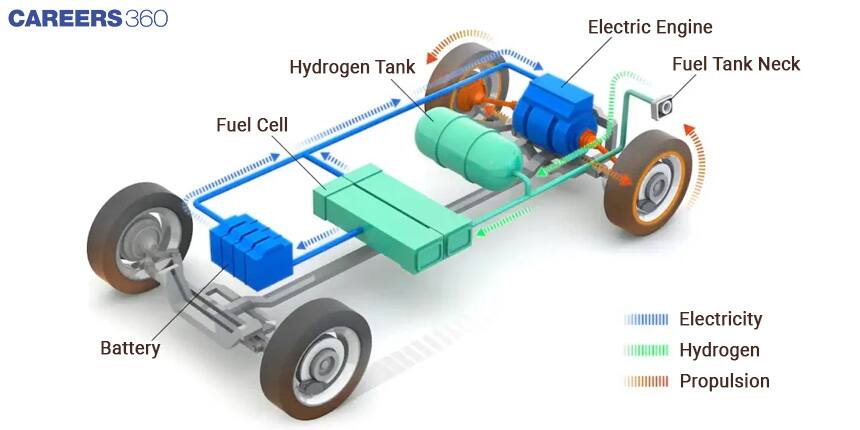Are You Aware Of The Physics Behind A Hydrogen-Powered Vehicle?
Imagine a future where the only emission from your vehicle is water vapour. A future where you can fuel up in minutes, not hours. A future where your car can even generate electricity in an emergency. This is the world of hydrogen fuel cell vehicles (FCVs).
This Story also Contains
- FCVs And Its Working
- Physics Of FCVs
- Challenges To Wider Adoption of FCVs
- Future Of FCVs

FCVs operate on the principles of science, not fiction, and have the potential to revolutionise the way we think about transportation. Unlike traditional gasoline-powered vehicles or battery electric vehicles (BEVs), FCVs generate electricity through a chemical reaction between hydrogen and oxygen. This reaction produces only water vapour, making FCVs a clean and sustainable option.
Despite the promise of FCVs, widespread adoption is still a work in progress. From the limited availability of hydrogen fueling stations to the high costs of production, there are a number of obstacles to overcome. But, with automakers investing in technology and governments offering incentives, the future of FCVs is looking brighter every day.
So, let’s dive into the world of FCVs and discover the potential of this cutting-edge technology. Are you ready to join the hydrogen revolution?
FCVs And Its Working
Hydrogen-powered vehicles, also known as fuel cell electric vehicles (FCEVs), offer an alternative to traditional gasoline-powered cars and new-age battery electric vehicles (BEVs). Unlike BEVs, which store energy in a lithium-ion battery pack, FCEVs use a fuel cell to generate electricity and power the motor. This results in a clean and sustainable mode of transportation, as the only by-product of the chemical reaction between hydrogen and oxygen is water vapour. With no harmful emissions produced, hydrogen vehicles offer an environmentally friendly option for drivers.
Hydrogen fuel cells, which are used in hydrogen vehicles, share a similar design to lithium-ion batteries. Both have an anode, a cathode, and a catalyst that facilitates the separation of electrons and protons. In hydrogen vehicles, multiple fuel cells are combined to form a stack, which generates electricity. Just like the lithium-ion cells in an electric vehicle battery, these fuel cells work together to power the vehicle. This concept of a fuel cell stack is unique to hydrogen vehicles and is crucial to their functioning.
The process of generating electricity in hydrogen vehicles occurs through reverse electrolysis, where hydrogen from the onboard fuel tanks is combined with oxygen inside the fuel cell stack. During this reaction, electrons are extracted from the hydrogen gas and sent through the circuit to power the motor. On the other side of the circuit, the electrons combine with oxygen to form water vapour, which is then released through the car's exhaust system. This process results in a clean and sustainable mode of transportation, with the only by-product being water vapour.

The electricity generated by the hydrogen fuel cells in a hydrogen vehicle can be utilised in two ways, depending on the driving situation. It can either be used directly to power the electric motor or it can be stored in a small lithium-ion battery for later use. This battery also acts as a storage system for excess power generated during low-energy driving and energy captured through the vehicle's regenerative braking system. When the vehicle requires additional power, the stored energy in the lithium-ion battery can be used to support the electric motor.
Physics Of FCVs
There are several key physics concepts used in fuel cell electric vehicles (FCVs):
Electrochemistry: Fuel cells rely on the principles of electrochemistry to generate electricity. The fuel cell stack combines hydrogen and oxygen to produce electricity, with water as the only byproduct.
Thermodynamics: The energy generated by the fuel cell is subject to the laws of thermodynamics, which dictate the efficiency and heat production of the system.
Hydrogen storage: The storage of hydrogen gas is a crucial aspect of FCVs. The gas must be stored at high pressures to increase the energy density and must be contained in a safe and secure manner.
Materials science: The materials used in fuel cell stacks must be highly conductive, durable, and able to withstand harsh operating conditions. Researchers are exploring advanced materials that can improve the performance and reliability of fuel cells.
Transport phenomena: The movement of hydrogen, oxygen, and water through the fuel cell stack must be carefully controlled to ensure efficient and stable operation. Understanding the transport of these species is crucial for optimising fuel cell performance.
By leveraging these concepts, researchers and engineers are working to improve the efficiency and affordability of fuel cell technology, making it a promising solution for reducing our reliance on fossil fuels and mitigating the impacts of climate change.
Also check - Should You Use A Heavy Or A Light Cricket Bat?
Challenges To Wider Adoption of FCVs
There are some challenges which are mentioned below:
The limited availability of hydrogen refuelling infrastructure is a major challenge to the wider adoption of fuel cell vehicles (FCVs). With only a few hundred hydrogen fueling stations globally, consumers are often hesitant to purchase an FCV because of concerns about being able to refuel their vehicles when travelling long distances.
High production costs are another challenge to the wider adoption of FCVs. FCVs are significantly more expensive than traditional gasoline-powered vehicles, and the components required to produce a fuel cell vehicle, such as the fuel cell stack, fuel tanks, and hydrogen production and distribution systems, are expensive to produce and install.
The energy required to produce hydrogen using current methods is also a challenge to the wider adoption of FCVs. Most hydrogen is produced from natural gas through a process called steam methane reforming, which is energy-intensive and releases greenhouse gases. This makes hydrogen production not yet a clean and sustainable method of energy production, which makes it challenging for FCVs to compete with electric vehicles that use renewable energy sources to recharge their batteries.
Range anxiety, or the fear of running out of fuel and being stranded, is another challenge to the wider adoption of FCVs. Although FCVs have a similar range to traditional gasoline-powered vehicles, the limited availability of hydrogen refuelling infrastructure can make consumers hesitant to purchase an FCV.
Misconceptions about the technology and its capabilities are also a challenge to the wider adoption of FCVs. Despite the advancements in FCV technology in recent years, some people still believe that FCVs are not as efficient or practical as traditional gasoline-powered vehicles or electric vehicles, which can make consumers hesitant to purchase an FCV, even if they are interested in the technology.
Future Of FCVs
The future of fuel cell electric vehicles (FCVs) is still uncertain, but the technology shows promise for a more sustainable future. There have been significant advancements in the development of hydrogen fuel cell technology, and the infrastructure for hydrogen refuelling has been slowly expanding, but there are still challenges to the wider adoption of FCVs.
However, with continued advancements in technology, the cost of FCVs is expected to decrease, making them more accessible to the general public. In addition, the development of new hydrogen production methods that rely on renewable energy sources could greatly increase the sustainability of FCVs.
In short, the future of FCVs is promising, but there are still significant challenges that need to be overcome. With continued investment in technology and infrastructure, FCVs have the potential to play a major role in the transition to a more sustainable transportation sector.
Also check - Truss Bridges: A Structural Marvel Made Possible By Triangles
Applications for Admissions are open.
As per latest syllabus. Physics formulas, equations, & laws of class 11 & 12th chapters
JEE Main Important Chemistry formulas
Get nowAs per latest syllabus. Chemistry formulas, equations, & laws of class 11 & 12th chapters
JEE Main high scoring chapters and topics
Get nowAs per latest 2024 syllabus. Study 40% syllabus and score upto 100% marks in JEE
JEE Main Important Mathematics Formulas
Get nowAs per latest syllabus. Maths formulas, equations, & theorems of class 11 & 12th chapters
